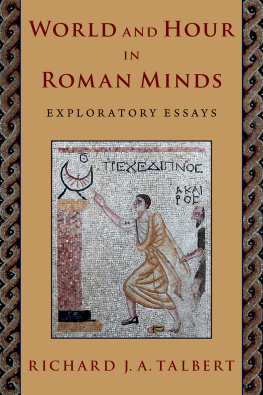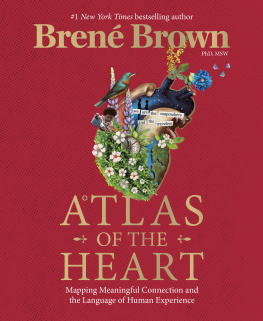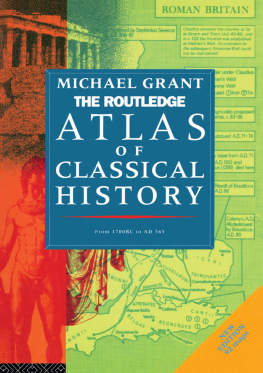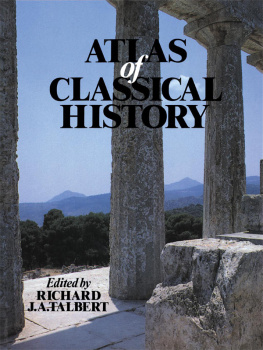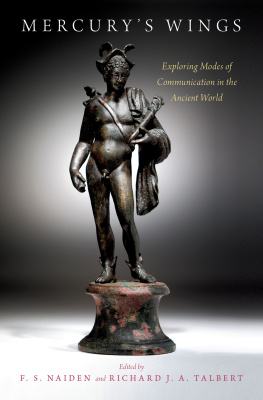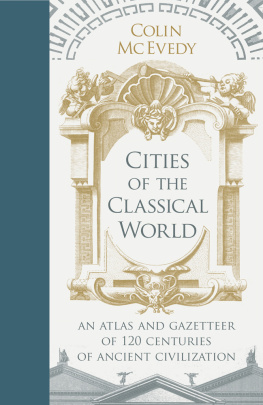
First published 2019
by Routledge
2 Park Square, Milton Park, Abingdon, Oxon OX14 4RN
and by Routledge
711 Third Avenue, New York, NY 10017
Routledge is an imprint of the Taylor & Francis Group, an informa business
2019 Richard J.A. Talbert
The right of Richard J. A. Talbert to be identified as author of this work has been asserted by him in accordance with sections 77 and 78 of the Copyright, Designs and Patents Act 1988.
All rights reserved. No part of this book may be reprinted or reproduced or utilised in any form or by any electronic, mechanical, or other means, now known or hereafter invented, including photocopying and recording, or in any information storage or retrieval system, without permission in writing from the publishers.
Trademark notice: Product or corporate names may be trademarks or registered trademarks, and are used only for identification and explanation without intent to infringe.
British Library Cataloguing-in-Publication Data
A catalogue record for this book is available from the British Library
Library of Congress Cataloging-in-Publication Data
Names: Talbert, Richard J. A., 1947 author.
Title: Challenges of mapping the classical world / Richard J.A. Talbert.
Description: Abingdon, Oxon; New York, NY: Routledge, 2018. | Includes bibliographical references
and index.
Identifiers: LCCN 2018014432 (print) | LCCN 2018030176 (ebook) | ISBN 9780429485688 (ebook) |
ISBN 9780429939471 (web pdf) | ISBN 9780429939464 (epub) | ISBN 9780429939457 (mobi/
kindle) | ISBN 9781472457820 (hardback: alk. paper)
Subjects: LCSH: Classical geography. | CartographyHistoryTo 1500.
Classification: LCC DE29 (ebook) | LCC DE29.T35 2018 (print) | DDC 912.38dc23
LC record available at https://lccn.loc.gov/2018014432
ISBN: 978-1-4724-5782-0 (hbk)
ISBN: 978-0-429-48568-8 (ebk)
Typeset in Times New Roman
by Apex CoVantage, LLC

It struck me years ago that a collection of my widely scattered writings on mapping the classical world from the nineteenth century onwards could have lasting value not just for the ancient field but also for the history of cartography. Colleagues, pupils and friends kindly endorsed this audacious supposition, and when, in 2014, I eventually sent a proposal to Michael Greenwood, then editor at Ashgate Publishing, he, too, reacted with enthusiasm. Accordingly, he and I first determined an appropriate length for the collection, and I then selected thirteen varied items written between 1990 and 2013; a single more recent one (2017) was inserted later. Among those left aside is my 2015 review in The Geographical Review of William Koelschs Geography and the Classical World: Unearthing Historical Geographys Forgotten Past (2013), an embarrassing illustration of how geographers today may be insufficiently aware of relevant initiatives undertaken outside their own departmental confines. Needless to say, the present book is not the place for any of my writings on map-making in antiquity itself.
The fourteen items in total are presented here in three distinct groups (as the Introduction explains) that mesh well with one another. The items have been published previously, except for a substantial trio relating to the generous support awarded by the U.S. National Endowment for the Humanities to the international collaborative project which I headed to produce what became the Barrington Atlas of the Greek and Roman World , published in 2000. No one but myself is to blame for the unduly long interval between Ashgates acceptance of the proposal and my delivery of the book. As ever, my estimate of how long it would take to clear prior commitments proved too optimistic. Meantime, Ashgate was acquired by Routledge (Taylor & Francis Group) in 2015.
Warm thanks are due to my editors initially Michael Greenwood, then Amy Davis-Poynter and Routledge staff; Tom Elliott, co-author of item 13; Mary Downs, for advice on presentation; George Gerolimatos, for assistance in translating the long German quotation in item 5; Lindsay Holman, current director of the Ancient World Mapping Center, for skilled help in preparing texts and images for production; Peter Raleigh, for advice and for formatting the previously unpublished items 8 10; and to all the presses and journals that have granted permission for items to be republished. Last, but far from least, my wife Zandra has cheerfully tolerated the gestation of yet another book, and I am grateful as always.
Richard J. A. Talbert
Chapel Hill, North Carolina
January 2018
Contents
Guide
13
Mapping the Ancient World (co-authored with Tom Elliott) in A. K. Knowles, ed., Past Time, Past Place: GIS for History (Redlands, CA: ESRI Press, 2002, pp. 14562)
Suppose that a student preparing a paper on the political and military activities of King Philip of Macedon comes across the following passage in a speech of Demosthenes, the famous Athenian orator:
Apparently those who inhabited Amphipolis, before Philip took it, were holding Athenian territory; but when he has taken it, it is no longer our territory, but his own, that he holds; and in the same way at Olynthus and Apollonia and Pallene he is in possession of his own property, not that of others.
Where would the student turn to find the location of these places and learn about their strategic importance in the fourth century B.C.? Upon consulting a gazetteer of the ancient world, the student might be surprised to learn that there was more than one place named Apollonia. Which one is Demosthenes talking about? Why does he bring it up at all?
Geographical questions would similarly confront a cultural historian studying the Roman conquest of the Po river valley in northeast Italy. A researcher who wanted to analyze how land was redistributed under the Romans and how that process affected the culture of the valley would want to conduct complex spatial analyses to examine temporal and spatial trends. But before any GIS work could begin, it would be necessary to consult literary and documentary sources, aerial photographs, and archaeological surveys. Deciding how to classify the ways the landscape was reorganized, identifying remnants of these patterns in the landscape, and dating them would require data that lies scattered in scores of archaeological investigations conducted over many decades. All these tasks would be complicated by the scarcity of reference maps showing the location of ancient settlements in the region.
For most of the twentieth century, students of antiquity faced serious difficulties if their research interests were geographical. Although nineteenth-century scholars of Greek and Roman history used cartography, the increasing specialization and diversification of academic disciplines distanced ancient history from its spatial context. The one important exception is the field of archaeology, which developed as a discipline almost entirely since the publication of the last comprehensive atlas of the Greek and Roman world in 1874.
Although various scholarly projects since 1900 have mapped particular aspects of ancient society, none collected and distilled enough of the centurys considerable published findings to provide a comprehensive source of spatial data on Greek and Roman antiquity. By 1980, the need for such a geographical and historical resource had become so acute that a report on research tools for the classics, published by the American Philological Association (APA), cited cartography as an area where the state of our tools is utterly disastrous. It was from this public recognition of the problem that the APAs Classical Atlas Project was born. In 1988 the project was headquartered at the University of North Carolina in Chapel Hill under the direction of Richard Talbert.
Next page

